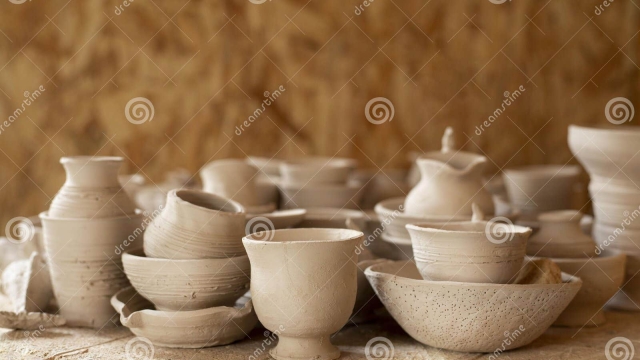
Pottery is more than just clay shaped by hands; it is a dance of creativity, history, and culture seamlessly intertwined. Each piece tells a story, carrying whispers of ancient traditions while inviting modern interpretations. The art of pottery has transcended generations, allowing skilled artisans to breathe life into inanimate materials. In this realm of creation, pottery becomes a vessel of dreams, transforming everyday objects into exquisite works of art.
At the forefront of this unique craftsmanship is Amitābha Studio, where the passion for pottery meets a love for history. Specializing in one-of-a-kind lamps, the studio breathes new life into antique and vintage Delft, as well as other Dutch and Belgian pottery. Each lamp is a blend of nostalgia and innovation, inviting illumination not just in a physical sense, but also in the warmth of memories and the beauty of craftsmanship. Journey with us as we explore the intricate world of pottery, where artistry and soul come together to shape dreams.
The History of Delft Pottery
Delft pottery, often referred to as Delftware, has its roots in the city of Delft in the Netherlands, dating back to the early 17th century. This unique style emerged as a response to the increasing popularity of Chinese porcelain, which inspired Dutch artisans to create their own version using local materials. Initially, Delft pottery was created as a cheaper alternative to the prized Asian ceramics, leading to the development of a distinctive style characterized by its blue and white designs.
Throughout the centuries, Delft pottery evolved, reflecting changes in artistic trends and consumer preferences. During the Dutch Golden Age, the production of Delftware flourished as European trade expanded, and the demand for decorative household items grew. Artisans began to incorporate intricate motifs, including pastoral scenes, floral patterns, and even narratives influenced by the burgeoning art movements of the time, establishing Delftware not just as functional objects, but also as collectible art pieces.
By the 18th century, the reputation of Delft pottery was firmly established throughout Europe, making it a symbol of Dutch craftsmanship. Although the production techniques and styles have evolved, the core principles of creativity and quality have remained vital. Today, artisans continue to celebrate this rich heritage, creating unique pieces that capture both the historical essence of Delft pottery and the innovative spirit of modern design, as seen in the work done at Amitābha Studio.
Crafting Unique Lamps
At Amitābha Studio, the artistry of pottery is transformed into stunning lighting fixtures that tell a story. Each lamp is designed to highlight the intricate details of antique and vintage Delft pottery, along with other exquisite Dutch and Belgian ceramics. The unique histories of these pieces are carefully preserved, ensuring that each lamp is not just a source of illumination but a conversation starter, filled with character and charm.
The process of crafting these lamps begins with a curated selection of pottery that has stood the test of time. Artisans at the studio meticulously clean and restore these rare finds, revealing their original beauty while maintaining their historical significance. By combining traditional pottery techniques with contemporary design elements, the studio creates lamps that seamlessly blend old-world craftsmanship with modern aesthetics.
Once the pottery is prepared, the team skillfully incorporates high-quality lighting systems that enhance the design without overshadowing its unique features. The result is a collection of lamps that not only brighten a room but also serve as beautiful focal points of interior decor. Each piece from Amitābha Studio embodies a perfect marriage of art and function, allowing the timeless allure of pottery to shine in a new light.
The Art Behind Each Piece
Every lamp crafted at Amitābha Studio tells a story, woven through the unique characteristics of antique and vintage Delft pottery. Each piece is a testament to the craftsmanship of eras gone by, showcasing intricate designs and the subtle imperfections that define true artistry. The studio’s dedication to sourcing these rare finds means that no two lamps are alike, imbuing each creation with a distinct personality that draws the eye and sparks conversation.
The process of transforming these cherished ceramics into functional art is a delicate balance of preservation and innovation. Artisans meticulously select every piece, considering not only the aesthetic but also the historical significance and narrative it carries. By integrating soft modern lighting with traditional materials, they breathe new life into the age-old pottery, creating pieces that resonate with both nostalgia and contemporary elegance.
This fusion of the past and present goes beyond mere aesthetics; it reflects an ethos of sustainability and respect for history. Each lamp is not just a source of light, but a bridge between generations. By choosing to repurpose vintage Delft and other Dutch and Belgian pottery, Amitābha Studio honors the artistry of the original makers while offering a fresh interpretation that brightens modern living spaces.
Sourcing Antique Pottery
Sourcing antique pottery requires a keen eye and an appreciation for history. At Amitābha Studio, the process begins with extensive research into various periods and styles of Dutch and Belgian pottery. The studio seeks out unique pieces that not only have aesthetic value but also tell a story of craftsmanship and culture. Every lamp crafted at the studio reflects this deep commitment to sourcing authentic antiques, ensuring that each creation carries a piece of history with it.
One of the unique aspects of sourcing antique pottery is building relationships with collectors and dealers. These connections often lead to the discovery of hidden gems that may not be readily available in the market. The process includes attending auctions, estate sales, and antique fairs, where the thrill of the hunt manifests in finding a beautiful piece that fits the vision for a new lamp. Each find is accompanied by its own narrative, connecting the past with the present through the art of transformation.
Grandmillennial Style
After acquiring the pottery, an essential part of the sourcing process is the careful inspection and restoration of each piece. While many items come in excellent condition, others may need minor repairs or cleaning to restore their original beauty. At Amitābha Studio, skilled artisans ensure that every piece of pottery is preserved with respect and care, preparing it to be an integral part of a bespoke lamp. This attention to detail not only enhances the quality of the final product but also honors the legacy of the antique pottery itself.
Sustainable Practices at Amitābha Studio
Amitābha Studio is committed to sustainability in every aspect of its pottery creation. By utilizing antique and vintage Delft and other Dutch and Belgian pottery, the studio minimizes the demand for new materials and helps preserve the rich history embedded in each piece. This not only reduces waste but also gives new life to items that might otherwise be discarded. Each lamp crafted at Amitābha Studio tells a story, bridging the past with modern design while championing eco-conscious practices.
In addition to repurposing materials, Amitābha Studio prioritizes environmentally friendly processes throughout its operations. The glazes used are often natural and free of harmful chemicals, ensuring that the finished products are safe for homes and the environment. The studio also embraces energy-efficient techniques during the firing process, reducing the carbon footprint associated with pottery production. This dedication to green practices reflects a deep respect for the earth and the resources it provides.
Community engagement is another cornerstone of Amitābha Studio’s sustainable philosophy. The studio collaborates with local artisans and suppliers to source materials responsibly, supporting the local economy and fostering relationships that prioritize sustainability. By working together, they create a ripple effect that encourages other businesses in the pottery and crafts community to adopt similar practices, paving the way for a more sustainable future in artistry.






Recent Comments